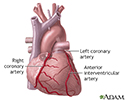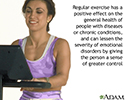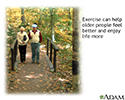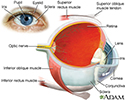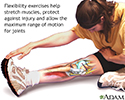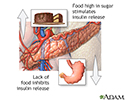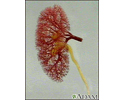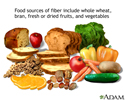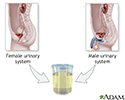Multimedia Gallery
Understanding cholesterol results
LDL cholesterol has gotten a bad reputation, and for very good reason. Having too much of this fatty substance in your blood can clog up your arteries, preventing blood from getting to your heart and out to where it's needed in your body. Checking your LDL levels can help your doctor spot high cholesterol before it can cause a heart attack or stroke. Let's talk today about LDL tests.
LDL stands for "low-density lipoprotein." Lipoprotein is a type of protein that transports cholesterol, as well as fats called triglycerides and lipids, in your blood. When you eat too many fatty, cholesterol-rich foods, LDL cholesterol can start to collect in your artery walls. That's one collection you don't want, because if a chunk of that gunk breaks loose and gets lodged in a blood vessel, you could end up having a heart attack or stroke.
To check your LDL cholesterol level, you'll need to have a blood test. Your doctor may tell you not to eat or drink anything for 8 to 12 hours before the test, so you can get an accurate reading.
During the test, your doctor will draw blood from one of your veins. The needle might sting a little bit, but the feeling shouldn't last for any more than a few seconds.
So, how do you know that you have high LDL cholesterol?
Well, your LDL cholesterol level (think: L for Lousy) will usually be measured along with your HDL, or good cholesterol (think: H for Healthy), as well as your triglycerides and your total cholesterol level. Together, these measurements are called a lipid panel.
You want your LDL level to be at least below 130 mg/dl, but ideally less than 100 milligrams per deciliter. If you're at high risk of heart disease, it should be even lower than that -- less than 70 milligrams per deciliter. And for folks of average risk of getting heart disease, anything over 160 is considered a high LDL level.
If you do have LDL cholesterol, you could be at risk for heart disease. Now, some folks have high cholesterol because they have an inherited condition that causes high cholesterol. If your LDL is low, it may be because you're not eating a well-balanced diet or your intestines aren't absorbing the nutrients from the foods that you eat.
Ask your doctor how often you should have your LDL, and total cholesterol levels, checked. Depending upon your heart disease risks, you may need to be tested more often. If your LDL cholesterol is high, ask your doctor about cholesterol-lowering medications, diet, and other ways to bring it back down into a normal range.
Understanding cholesterol results
Review Date: 1/1/2025
Reviewed By: Michael A. Chen, MD, PhD, Associate Professor of Medicine, Division of Cardiology, Harborview Medical Center, University of Washington Medical School, Seattle, WA. Also reviewed by David C. Dugdale, MD, Medical Director, Brenda Conaway, Editorial Director, and the A.D.A.M. Editorial team.
Animations
- Blood pressure
- Bunion
- Cataract
- Childhood obesity
- Cholesterol and triglycerid...
- Coronary artery disease
- Depression
- Diabetes
- Diabetes - retinal conditions
- Diabetes and risk of seriou...
- Dialysis
- Erection problems
- Exercise
- Foot pain
- Gallstones
- Glaucoma
- Hardening of arteries
- HbA1c
- Healthy Guide to Fast Food
- Heart attack
- Hypertension
- Hypertension - overview
- Immune response
- Smoking
- Smoking tips to quit
- Stroke
- Stroke
- The goals of proper type 2 ...
- Tobacco use - effects on ar...
- Tracking your blood pressur...
- Type 1 diabetes
- Type 2 diabetes
- Understanding cholesterol r...
- Urinary incontinence
- Urinary tract infection - adults
- Vaccines
- Venous insufficiency
Illustrations
- 15/15 rule
- Abdominal girth measurement
- Abdominal muscles
- Acanthosis nigricans - close-up
- Acanthosis nigricans on the hand
- Acute MI
- Adjustable gastric banding
- Aerobic exercise
- Alpha-glucosidase inhibitors
- Angina
- Anterior heart arteries
- Atherosclerosis of the extr...
- Autonomic Nerves
- Baby bottle tooth decay
- Benefit of regular exercise
- Biguanides
- Blood pressure
- Blood pressure check
- Blood test
- Blood test
- Brain
- Brainstem function
- Calculating body frame size
- Candida - fluorescent stain
- Candidiasis, cutaneous - ar...
- Carotid dissection
- Carotid stenosis - X-ray of...
- Carpal tunnel syndrome
- Cataract - close-up of the eye
- Central nervous system
- Central nervous system and ...
- Cerebellum - function
- Childhood obesity
- Children's diets
- Cholesterol
- Cholesterol producers
- Circle of Willis
- Circulation of blood throug...
- Complex carbohydrates
- Coronary artery blockage
- Coronary artery disease
- Creatinine tests
- DASH diet
- Dermatitis - reaction to tinea
- Dermatitis - stasis on the leg
- Developmental process of at...
- Diabetes and exercise
- Diabetes and nerve damage
- Diabetes risk factors
- Diabetic blood circulation ...
- Diabetic emergency supplies
- Diabetic foot care
- Diabetic foot care
- Diabetic nephropathy
- Diabetic retinopathy
- Different types of weight gain
- Digestive system
- Endarterectomy
- Endocrine glands
- Energy levels
- Exercise - a powerful tool
- Exercise 30 minutes a day
- Exercise and age
- Exercise and heart rate
- Exercise can lower blood pr...
- Exercise with friends
- Eye
- Fast food
- Fasting plasma glucose test
- Female reproductive anatomy
- Female urinary tract
- Femoral nerve damage
- Fish in diet
- Flexibility exercise
- Follicle development
- Folliculitis - decalvans on...
- Folliculitis on the leg
- Food and insulin release
- Food label guide for candy
- Food label guide for whole ...
- Foot swelling
- Fruits and vegetables
- Fungus
- Gestational diabetes
- Gingivitis
- Gingivitis
- Glaucoma
- Glucose in blood
- Glucose test
- Granuloma - fungal (Majocchi's)
- Granuloma - fungal (Majocchi's)
- Granuloma annulare - close-up
- Granuloma annulare on the elbow
- Granuloma annulare on the eyelid
- Granuloma annulare on the legs
- Hair follicle anatomy
- Hammer toe
- Healthy diet
- Healthy diet
- Heart - front view
- Heart - section through the...
- Heart attack symptoms
- High blood pressure tests
- Influenza
- Influenza vaccines
- Ingrown toenail
- Insulin production and diabetes
- Insulin pump
- Insulin pump
- Islets of Langerhans
- Isometric exercise
- Jaw pain and heart attacks
- Kidney - blood and urine flow
- Kidney anatomy
- Kidneys
- Left cerebral hemisphere - ...
- Lifestyle changes
- Lipocytes (fat cells)
- Low blood sugar symptoms
- Male urinary system
- Male urinary tract
- Monitoring blood pressure
- myPlate
- Nail infection - candidal
- Necrobiosis lipoidica diabe...
- Necrobiosis lipoidica diabe...
- Nervous system
- Nervous system
- Normal uterine anatomy (cut...
- Obesity and health
- Omega-3 fatty acids
- Oral glucose tolerance test
- Osmolality test
- Pancreas
- Pancreas and kidneys
- Pelvic laparoscopy
- Pesticides and fruit
- Pharmacy options
- Physical activity - prevent...
- Pituitary and TSH
- Plaque buildup in arteries
- Pneumococcal vaccine
- Post myocardial infarction ...
- Posterior heart arteries
- Prevention of heart disease
- Progressive build-up of pla...
- Proteins
- Quitting smoking
- Radial nerve dysfunction
- Read food labels
- Retinal dye injection
- Right cerebral hemisphere -...
- Ringworm - tinea corporis o...
- Ringworm - tinea corporis o...
- Ringworm - tinea manuum on ...
- Ringworm - tinea on the han...
- Ringworm of the scalp
- Ringworm, tinea capitis - c...
- Roux-en-Y stomach surgery f...
- Salad nutrients
- Saturated fats
- Secondary infection
- Simple carbohydrates
- Slit-lamp exam
- Smoking hazards
- Sources of fiber
- Soy
- Stable angina
- Starchy foods
- Stein-Leventhal syndrome
- Stomach
- Stomach disease or trauma
- Stye
- Sulfonylureas drug
- Surface anatomy - normal palm
- Surface anatomy - normal wrist
- Swollen gums
- Thiazolidinediones
- Thyroid uptake test
- Tinea corporis - ear
- Tinea versicolor - close-up
- Tinea versicolor - close-up
- Tinea versicolor - shoulders
- Tinea versicolor on the back
- Tooth anatomy
- Tooth anatomy
- Trans fatty acids
- Type I diabetes
- Ulnar nerve damage
- Untreated hypertension
- Urine sample
- Uterus
- Vaginal discharge
- Visual field test
- Vitiligo
- Vitiligo - drug induced
- Vitiligo on the back and arm
- Vitiligo on the face
- Weight loss
- White nail syndrome
- Wood's lamp test - of the scalp
- Wrist anatomy
- Xerosis - close-up
- Yeast and mold
- Yeast infections
- Yoga
- Yo-yo dieting

 Bookmark
Bookmark















































